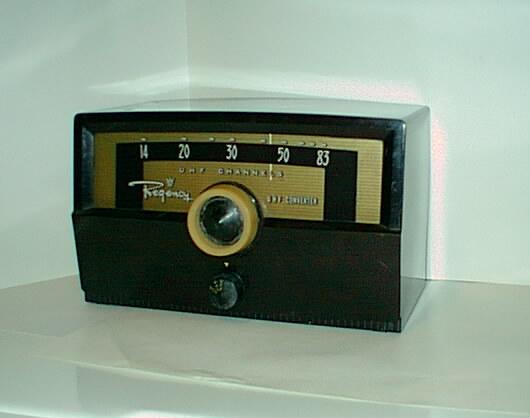Regency RC-600

|
I.D.E.A., of Indianapolis, Indiana (also home to RCA's Home Instrument Division), had sold a successful line of TV boosters under the Regency name for several years when they got into the UHF converter business in late 1952. This large and expensive model ($50 list) was the top of the line. Its styling suggests influence from some of neighbor RCA's early '50s plastic radios.
The circuitry reflects the early attempts of the television industry to find ways of making mass-producible UHF tuners. Almost half the chassis is occupied with a "tuning drum" that contains not only the input and oscillator tuned circuits but also both the oscillator (6AF4) and IF amp (6BK7) tubes. The 6BK7 was located in the center of the drum and was accessed from the front of the chassis (once you removed it from the cabinet of course), and the 6AF4 was accessed through a trap door in the top of the drum. Both tubes had puller straps included to make their removal possible. Service instructions indicate that, aside from the tubes, there were no practically-serviceable parts -- in case of problems, the entire unit was to be returned to the factory. As with most converters, the circuit depended on the ubiquitous 6AF4 triode oscillator and a crystal diode mixer. The IF amplifier was a low-noise dual triode in a cascode configuration. The IF itself was a bit unusual -- from the factory it was tuned to channel 10, rather than the more common 5 or 6, and could be field-adjusted between channel 8 and 13. Power came from the usual small transformer and selenium rectifier. |
Updated December 7, 2023